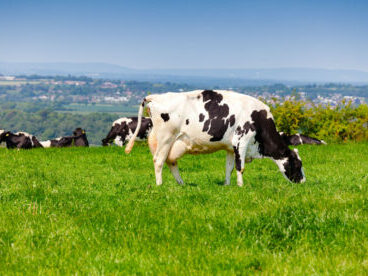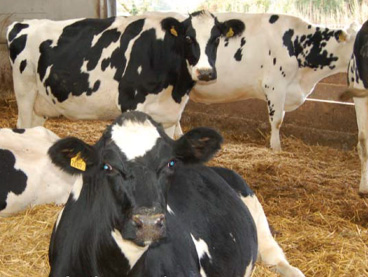A science-led approach to dairy diets relies on the accurate measurement of true energy and protein values, to achieve a sustainable and profitable future. By Stuart Booker
It is misleading to adopt feeding systems in dairy herds based on calculations developed from calorimetric data published more than 30 years ago, according to a group of leading UK nutritionists and advisers.
With growing pressure on producers to meet sustainability and responsibility goals with stricter milk contracts, as well as ever tighter margins, a science-led approach is key to maximising efficiencies. But this relies on accurate measurement of energy and protein values in rations, if producers are to increase yields and productivity, as well as protecting and improving health and fertility.
The Trade and Agriculture Commission outlined its recommendations to Government for a future productive and profitable UK agri-food sector, with a strong focus on environmental responsibilities and alignment with the UN’s sustainability goals.
But how does this marry up with developing feeding strategies to help maintain productivity in dairy herds, with no adverse effect on milk yield or quality, or health and fertility?
Key is understanding the specific energy and protein requirements of the herd, to ensure rations comprise the correct balance of all nutrients required, including fatty acids.
While precision feeding models will help cows to realise their genetic potential, there are significant concerns about reliance on energy calculations that are not fit for purpose, given the improvements in dairy cow productivity.

Cows are now genetically very different, as are the raw materials we are feeding. Yet some are still using feeding systems based on AFRC (Agricultural and Food Research Council) calculations from 30 years ago, explains Massey Feeds’ Dai Lewis.
“It is illogical. We are not dealing with the same animals or the same raw materials, so we should not use the same calibrations,” he says.
The average dairy cow produces 60% more milk compared to 30 years ago, resulting in a 40% reduction in the size of the national dairy herd during this period. To understand true nutritional requirements, calculations must be based on today’s animal, not a 1990s cow. And the aim must be to maximise potential by better utilising the ration.
Fatty acids
Different fatty acids contained in rumen protected, or rumen inert, fat supplements are linked to specific metabolic processes of milk production, reproduction, growth and health. Understanding the different roles, and feeding at the correct balance to meet the cows’ needs at different stages of lactation, is vital. Factors including actual oil content, digestibility and the synergistic effects of blends of oils and fats will all determine the overall ME supply to the cow.
“In terms of energy values, you can assume calibrations are correct,” adds Mr Lewis, “That’s fine, but would only be relevant under optimal rumen conditions.”
As an example, calcium soaps are typically listed in the UK with an ME of 33MJ/kgDM, a figure based on calculations that would only be correct if the fat is 100% digestible. Other bodies, such as the NRC in the US, say 79.5% digestibility and an ME of 26.2MJ/kgDM. So why are we different?
DBL Buying Group’s Andrew Jones says it should not be about a headline ME figure. “What use is that without talking about the digestibility and utilisation of that product within the cow?
“Consideration of a fatty acid composition in a blend of oils and fats will be more useful than a reliance on single face values, such as ME, of a fat product. For example, inclusion of C16:0 helps improve digestibility of forages, whereas C18:1 improves total fat digestibility, helping cows utilise more of the diet, rather than just relying on a headline figure and expecting it to be achieved,” he adds.
According to independent nutritionist Rob Mintern, the golden rule is to get the basics right. “While the correct fat blend will help maximise use of home-grown feeds and forages, these still need to be the best possible quality.
“Producers then need to ensure the whole diet is well balanced. Only then will the best fat blend, based on highly digestible soft oils, help to push profits,” he says.
“My approach is to maximise dry matter intakes,” adds independent consultant Barry Audis. “And this involves looking at all the parameters not only energy or crude protein, but also bypass protein and intestinal digestible protein.”
He says 1kg of dry matter should equal two litres of milk – and this can be achieved by maximising intakes.
“When I go on farm, I want to know the exact ration cows have been fed for the previous four days, to assess the average dry matter intake at that time linked to the current milk production.
“I then aim for a diet that achieves between 5% and 10% more milk than those cows are giving at the current dry matter intake, so there’s sufficient nutrient intake.”
Energy density
Harpers Feeds’ Richard Waters says getting the balance right is crucial. “Milk protein, on all contracts, is hugely valuable, so it is essential to keep the energy density of the diets high. On some units I have been able to remove soya and palm from diets, while maintaining a steady climb in performance with excellent milk quality by feeding a TMR containing alternative sources of C16,” he explains.
Mr Waters believes the introduction of omega 3 sources has also strongly supported an improvement in fertility.
Recent pressures to remove or reduce soya and palm from dairy rations can be compared to the removal of fishmeal – a ready source of omega 3s, EPA and DHA.
“Many producers will remember having fishmeal in the mix. Using sustainably sourced marine oils to replicate those benefits is clearly a positive,” adds Andrew Jones.
“It is about getting the right balance. C16 fats, for example, do not need to be the cornerstone of the ration if it’s correctly formulated to achieve good butterfat production.
“In 2020 a client switched from a 70% C16 product to a palm-free alternative, and not only reduced ration costs but also saw improved butterfats during the winter.”
“Consumers and processors are demanding the move to sustainable feed sources, and we have the tools to make it work. And moving away from 30-year-old data is a good start.”


 Back to News
Back to News 



